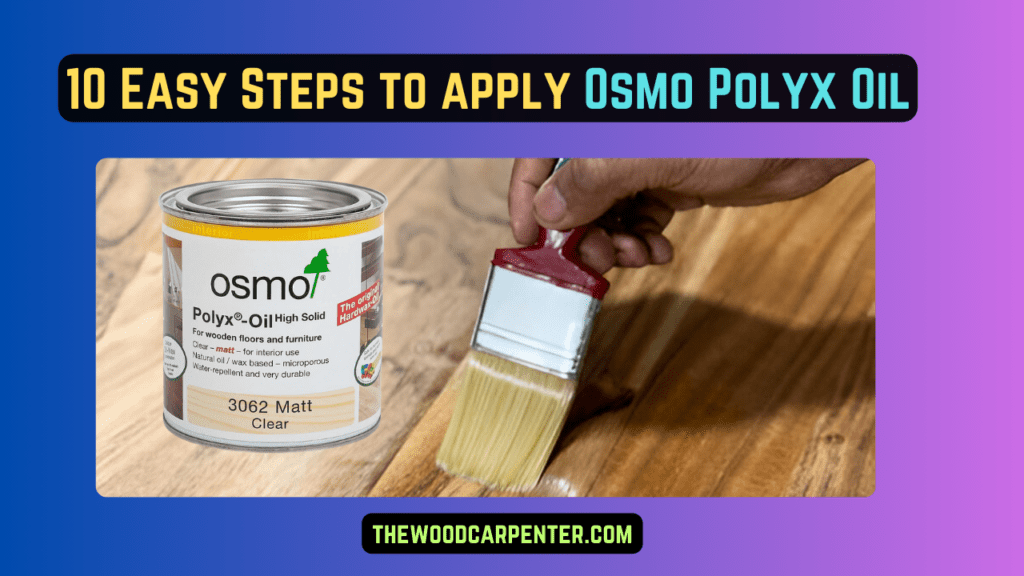
Osmo Polyx Oil
Osmo Polyx Oil is a premium oil and wax-based product designed to protect and enhance the natural beauty of wood. If you’re looking for a long-lasting, durable, and environmentally friendly solution for your wooden surfaces, this is the product you need.
It’s ideal for floors, furniture, and other wood surfaces, offering a beautiful finish that is both hard-wearing and easy to maintain.
Why Choose Osmo Polyx Oil for Your Wooden Surfaces
Durability and Protection
Osmo Polyx Oil is renowned for its incredible durability. It penetrates deep into the wood, offering protection from within, while the wax component forms a surface layer that resists water, dirt, and everyday wear. This means your wood stays protected longer, even in high-traffic areas.
Eco-Friendly and Natural Ingredients
Osmo Polyx Oil is made from natural plant oils and waxes, making it an eco-friendly choice. You won’t have to worry about toxic chemicals or harmful VOCs. It’s a perfect option for those who want a green, sustainable approach to wood care.
Preparing to Apply Osmo Polyx Oil
Gathering Tools and Materials
Before you start, ensure you have all the necessary tools: Osmo Polyx Oil, a good-quality brush or roller, sandpaper (in various grits), a clean cloth, and a stirring stick. It’s also helpful to have a vacuum or tack cloth to remove dust from the surface.
Safety Considerations
Even though Osmo Polyx Oil is a natural product, always work in a well-ventilated area. Make sure to wear gloves and keep the room well-ventilated to avoid prolonged exposure to the product.
Step 1: Sanding the Wooden Surface
Importance of Sanding
Sanding is crucial for preparing the surface. It helps to smooth out imperfections and opens up the pores of the wood, allowing the oil to penetrate more effectively.
Types of Sandpaper to Use
Start with a medium grit (120) to remove any rough patches, then finish with a fine grit (180–240) to create a smooth surface ready for oiling.
Step 2: Cleaning the Surface
Why You Need a Clean Surface
Any dust or dirt left on the surface will prevent the oil from absorbing properly. Cleanliness is key to ensuring a smooth and even finish.
Recommended Cleaning Solutions
You can either use a tack cloth or a damp rag to wipe it down. Avoid using harsh chemicals, as they can interfere with the oil’s absorption.
Step 3: Stirring the Osmo Polyx Oil
Importance of Stirring
Oil and wax can separate over time. Stirring the product ensures an even consistency, so you get the right balance of oil and wax with every application.
How to Properly Stir the Oil
Use a stirring stick to mix the oil thoroughly. Be sure not to shake the can, as this can create bubbles, which might affect the final finish.
Step 4: Applying the First Coat
Tools to Use: Brush or Roller?
A natural bristle brush or microfiber roller works best for applying Osmo Polyx Oil. Brushes are great for detailed areas, while rollers cover larger surfaces quickly.
Applying the Oil Evenly
Dip the brush or roller into the oil and apply it in thin, even coats. Work with the grain of the wood, and make sure you don’t leave any puddles or thick spots.
Step 5: Waiting for the First Coat to Dry
How Long to Wait
Allow the first coat to dry for about 8-10 hours. Drying time can vary based on humidity and temperature, so check the surface before proceeding to the next step.
Ideal Drying Conditions
The best drying conditions are in a well-ventilated room with moderate humidity. Avoid applying oil in extremely humid or cold environments, as this can prolong drying time.
Also read:
Wood Finishes 101: Make the Right Choice for your project !
Beeswax Wood Finish: The Secret to Stunning Wood
Wood Putty or Wood Filler? Stop Making the Wrong Choice!
Step 6: Light Sanding Between Coats
Why You Need to Sand Between Coats
Sanding between coats helps to smooth out any raised grain and prepares the surface for the second application. This step is essential for a flawless finish.
Best Sanding Practices
Use very fine sandpaper (320 grit) and sand lightly in the direction of the grain. Once you’ve finished sanding, make sure to thoroughly clean the surface to get rid of all the dust.
Step 7: Applying the Second Coat
Techniques for a Smooth Finish
Apply the second coat just like the first—thin, even, and with the grain of the wood. This second layer enhances durability and deepens the wood’s natural color.
Avoiding Streaks and Bubbles
To avoid streaks, use smooth, continuous strokes. Be sure to apply thin coats, as thicker applications can result in bubbles.
Step 8: Letting the Second Coat Dry
Drying Time for the Final Coat
The second coat should also dry for 8-10 hours. Resist the urge to touch the surface before it’s completely dry to avoid smudges or fingerprints.
When to Touch and Use the Surface
After 24 hours, the surface will be fully cured and ready for light use. However, for full hardness, wait up to 2 weeks before subjecting it to heavy traffic.
Step 9: Final Buffing and Polishing
Buffing for a Smooth, Satin Finish
Once the oil has dried, buff the surface with a soft cloth or a mechanical buffer to give it a smooth, satin finish. Buffing also helps the oil settle into the wood.
Tools for Polishing
A soft microfiber cloth works well for hand buffing, while a polishing pad attachment can be used for larger surfaces.
Step 10: Maintenance and Aftercare
How to Keep the Surface Looking Great
To maintain the finish, clean the surface regularly with a dry or damp cloth. Avoid using abrasive cleaners that can damage the oil finish.
Reapplication Guidelines
Depending on the wear and tear, reapply Osmo Polyx Oil every few years to keep your wood protected and looking fresh.
Common Mistakes to Avoid When Using Osmo Polyx Oil
Applying Too Much Oil
Too much oil can result in a sticky surface that doesn’t dry properly. Always apply thin coats to avoid this.
Not Sanding Properly
Skipping the sanding step or not sanding enough can lead to an uneven finish. Take your time to ensure the wood is smooth and ready for oiling.
Conclusion
Osmo Polyx Oil is a fantastic product that not only protects but also enhances the natural beauty of your wood surfaces. By following these 10 simple steps, you can achieve a professional-looking finish that lasts for years.
Whether you’re refinishing floors, furniture, or other wooden items, Osmo Polyx Oil will give your wood a durable, beautiful, and eco-friendly finish.
FAQs
1. How long does Osmo Polyx Oil last?
Osmo Polyx Oil can last several years, depending on the level of wear and the frequency of maintenance.
2. Can I use Osmo Polyx Oil on outdoor surfaces?
No, Osmo Polyx Oil is designed for indoor use. For outdoor applications, Osmo offers specific products designed for exterior wood.
3. What is the best way to clean a surface treated with Osmo Polyx Oil?
Use a dry or damp cloth for regular cleaning. Avoid harsh chemicals, as they can strip the oil from the surface.
4. How many coats of Osmo Polyx Oil should I apply?
Two thin coats are generally sufficient for most applications, but high-traffic areas may benefit from a third coat.
5. Can I apply Osmo Polyx Oil over an existing finish?
No, it’s best to sand down any existing finishes before applying Osmo Polyx Oil to ensure proper adhesion and absorption.

